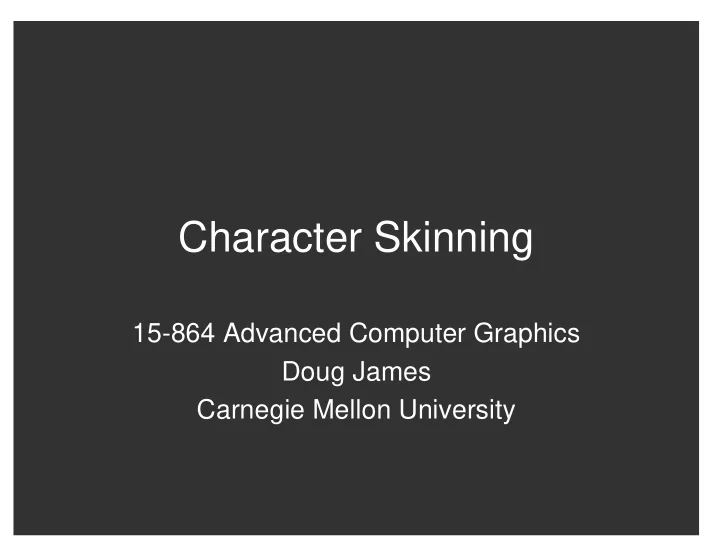

Character Skinning 15-864 Advanced Computer Graphics Doug James Carnegie Mellon University
Overview • Shape interpolation • Skinning basics; Linear blending • Pose Space Deformation – EigenSkin hardware implementation • Multi-weight Enveloping
Shape Interpolation • or “blend shapes” • Widely used for facial animation • Sliders control shape contributions • Problems: – Shapes are not independent – Interpolation artifacts – Bad for articulation
Most common skinning method… • Many names… – Skeleton-subspace deformation (SSD) – linear blending • linear (vertex,transform,…) blending – skinning • matrix palette skinning – enveloping – etc. • Very simple approach • Common skinning assumption: sequence of static poses dependent on skeleton joint angles, …
Skeleton-Subspace Deformation Vertices grouped by Weights are arbitrary common bone influences - Defined by an artist Groups are arbitrary - Function of vertex-bone distances
SSD Pros/Cons • Pros: – easy, fast, and supported in hardware • Cons: – Range of deformations is limited • Hence “skeleton-subspace deformations” • Unsuitable for more general deformations – Buckling, poor behavior, limited expression
SSD Limitations
SSD Limitations
(But it’s fast…) Hardware Implementation • OpenGL/DirectX support • Vertex program implementation • Each vertex deformed independently • Per-vertex memory: – position, normal, bone weights/indices, … • Constant memory: – bone transforms, …
Erik Lindholm, Mark J. Kilgard, and Henry Moreton, A User-Programmable Vertex Engine, Proceedings of ACM SIGGRAPH 2001. pp. 149-158, 2001.
Pose Space Deformation • J. P. Lewis, Matt Cordner and Nickson Fong, Pose Space Deformations: A Unified Approach to Shape Interpolation and Skeleton-Driven Deformation , Proceedings of ACM SIGGRAPH 2000 . pp. 165-172, 2000. • Optimized graphics hardware implementation: – Paul G. Kry, Doug L. James and Dinesh K. Pai, EigenSkin: Real Time Large Deformation Character Skinning in Hardware , ACM SIGGRAPH Symposium on Computer Animation. pp. 153-160, 2002. – EigenSkin slides…
Multi-Weight Enveloping • Idea: Instead of interpolating all the data, … Fit a simple/fast skinning model • Xiaohuan Corina Wang and Cary Phillips, Multi-Weight Enveloping: Least-Squares Approximation Techniques for Skin Animation , ACM SIGGRAPH Symposium on Computer Animation . pp. 129-138, 2002.
MWE Goals
Outline of Remaining Classes March No class (SIGGRAPH papers meeting) Radiometry; Global Illumin. April Project proposal due Solving the Rendering Equation Project progress report Photon Mapping assignment due Image based rendering; aliasing; … Projects due: May 2 Presentations?
Project Proposal (due Apr 1 in class) • 2 pages or less • Prefer SIGGRAPH style LaTeX formatting • http://www.siggraph.org/publications/instructions • Proposal structure: 1. Abstract 2. Introduction (What, why, related work) 3. Details of approach 4. Proposed work (incrementally defined) 1. Will do (core material) 2. Hope to do (time-permitting) 3. Ultimately would like to do (if 1 & 2 get done) 5. Summary of proposed contributions 6. Use graphbib for References: http://www.siggraph.org/publications/bibliography
Recommend
More recommend